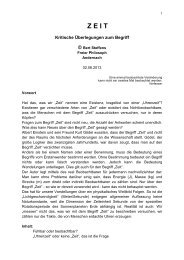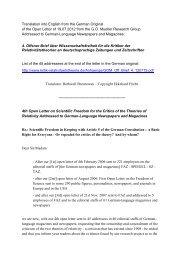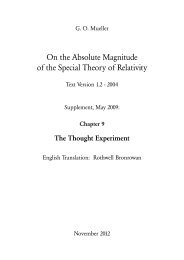2394 weitere kritische Veröffentlichungen - Kritische Stimmen zur ...
2394 weitere kritische Veröffentlichungen - Kritische Stimmen zur ...
2394 weitere kritische Veröffentlichungen - Kritische Stimmen zur ...
Sie wollen auch ein ePaper? Erhöhen Sie die Reichweite Ihrer Titel.
YUMPU macht aus Druck-PDFs automatisch weboptimierte ePaper, die Google liebt.
Unzicker, Alexander 2005<br />
Mach's principle and a variable speed of light / A. Unzicker.<br />
- [Deutschland]: WWW 2005. 13 S.<br />
URL: http://www.alexander-unzicker.de/<br />
GravNablaC.pdf - Status: Kritik. - Quelle: Autopsie.<br />
Unzicker, Alexander 2010<br />
Vom Urknall zum Durchknall: die absurde Jagd nach<br />
der Weltformel / Alexander Unzicker. - Berlin: Springer<br />
2010. 330 S.<br />
Status: Kandidat. - Quelle: Spektrum der Wiss. 2010,<br />
Aug., S. 100.<br />
Valdivia, Rafael de 1947<br />
Algunas dificultades en la teoría de la relatividad /<br />
Rafael de Valdivia.<br />
In: Ibérica. 1947, Nr. 123, II, p. 264-268.<br />
Status: Kandidat. - Quelle: Soler Ferran 2009 (Teoria).<br />
Valev, Pentcho 2004<br />
Science infected with inconsistency: [datiert: 27.5.04]<br />
/ Pentcho Valev.<br />
In: The general science journal. 2004 =<br />
http://www.wbabin.net/valev/valev.pdf - 7 S.<br />
SRT. ERK.<br />
"Abstract - A theory can be regarded, in the abstract, as a<br />
set of propositions. If there are circumstances, either<br />
realistic or unrealistic, under which all the propositions in<br />
the set are true, the theory is consistent. If there are no<br />
such circumstances - e.g. the set contains the propositions<br />
"Henry is married" and "Henry is not married" -<br />
the theory can be called an inconsistency. An inconsistent<br />
theory is extremely dangerous since, somewhat<br />
paradoxically, it may possess a great deductive power<br />
and produce breathtaking conclusions. Moreover, if it<br />
occupies scientists' minds for a long time, reasoning in<br />
terms of inconsistent propositions becomes "normal",<br />
the logical procedure reductio ad absurdum stops working<br />
and returning to a consistent conceptual framework<br />
proves impossible in the end. Special relativity and<br />
thermodynamics are perhaps the most successful inconsistencies<br />
ever created."<br />
Valev, Pentcho 2005<br />
Albert Einstein: the lucky jugler: [datiert: 12.4.05] /<br />
Pentcho Valev.<br />
In: The general science journal. 2005 =<br />
http://wbabin.net/valev/valev6.pdf - 2 S.<br />
SRT. ERK.<br />
Auszug: "In an oversimplified presentation, the method<br />
Einstein used in the creation of his theory of relativity<br />
can be reduced to the following simple rules:<br />
G. O. Mueller: SRT. Kap. 4-Erg.<br />
312<br />
1. Introduce a false axiom (the postulate of constancy<br />
of the speed of light).<br />
2. Draw on all the miracles (time dilation, length<br />
contraction, conversion of time into space, conversion<br />
of space into time etc.) the false axiom produces and<br />
become god-like.<br />
3. In the capacity of a god, do all necessary tricks so<br />
as to hide all dangerous inconsistencies generated by<br />
the false axiom."<br />
Valev, Pentcho 2005<br />
Incommensurability of Newton and Einstein: [datiert:<br />
22.5.05] / Pentcho Valev.<br />
In: The general science journal. 2005 =<br />
http://wbabin.net/valev/valev7.pdf - 1 S.<br />
SRT. NEWTON. ERK.<br />
Auszüge: "One of the most striking claims advanced<br />
by T. Kuhn and P. Feyerabend, both classified as nonrationalists<br />
among philosophers of science, is that Newtonian<br />
mechanics and Einsteinian mechanics neither<br />
contradict nor agree with one another; they are just<br />
incommensurable. This means that in the transition<br />
from one to the other there has been a shift in meaning<br />
so extreme that the assertions of two respective proponents<br />
would simply pass one another by without any<br />
collision leading to either agreement or conflict. If the<br />
Newtonian says, for instance, "The ball will fall in the<br />
hole if its diameter is smaller", no reply by the Einsteinian<br />
can be construed as compatible or incompatible;<br />
the two persons are merely equivocating. [...]<br />
Clearly, Kuhn and Feyerabend are right about incommensurability<br />
(although their arguments are different<br />
from mine). In Newtonian mechanics assertions are<br />
straightforward. In Einsteinian mechanics assertions are<br />
accompanied by their negations. Proponents of the two<br />
theories can neither agree nor disagree - they can only<br />
equivocate."<br />
Valev, Pentcho 2005<br />
Relativity: the madness of 20th century physics: [datiert:<br />
5.3.05] / Pentcho Valev.<br />
In: The general science journal. 2005 =<br />
http://wbabin.net/valev/valev3.pdf - 4 S.<br />
SRT. LORTF. ZD. LK. EHRENFEST. ERK. HIST. SOZIO.<br />
Auszug: "In his book "The Tragicomical History of<br />
Thermodynamics 1822-1854" C. Truesdell characterises<br />
this science as "a prime example to show that physicists<br />
are not exempt from the madness of crowds". Since<br />
thermodynamics can be defined as a 19th century<br />
science, Truesdell could have called it, accordingly,<br />
"the 19th century prime example". However the logical<br />
paradigm set out by 19th century thermodynamicists<br />
has developed so that the 20th century "prime example"<br />
is undoubtedly relativity. The present paper contains a<br />
malicious scenario presenting the main protagonist, Al-<br />
Textversion 1.2 - 2012





